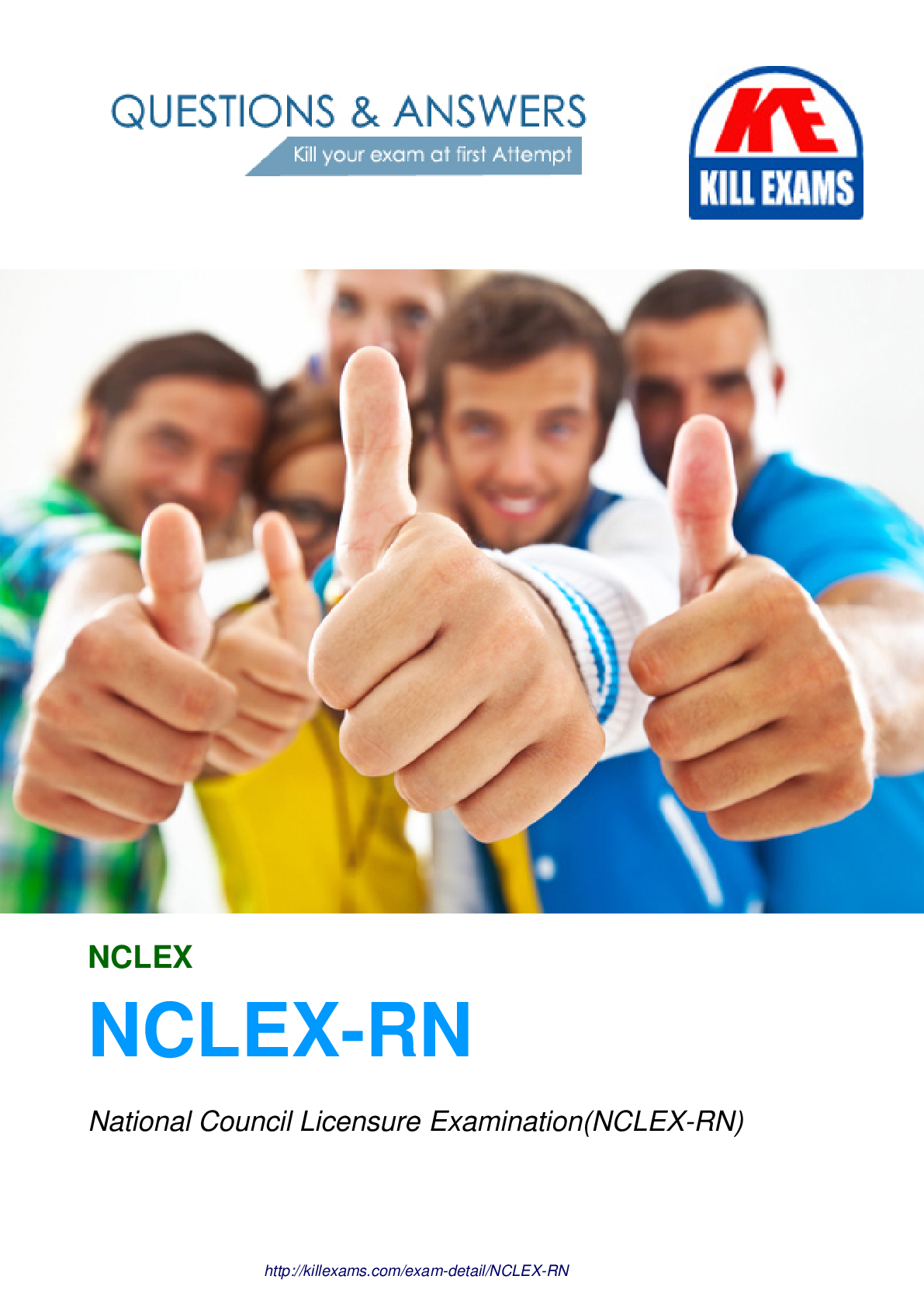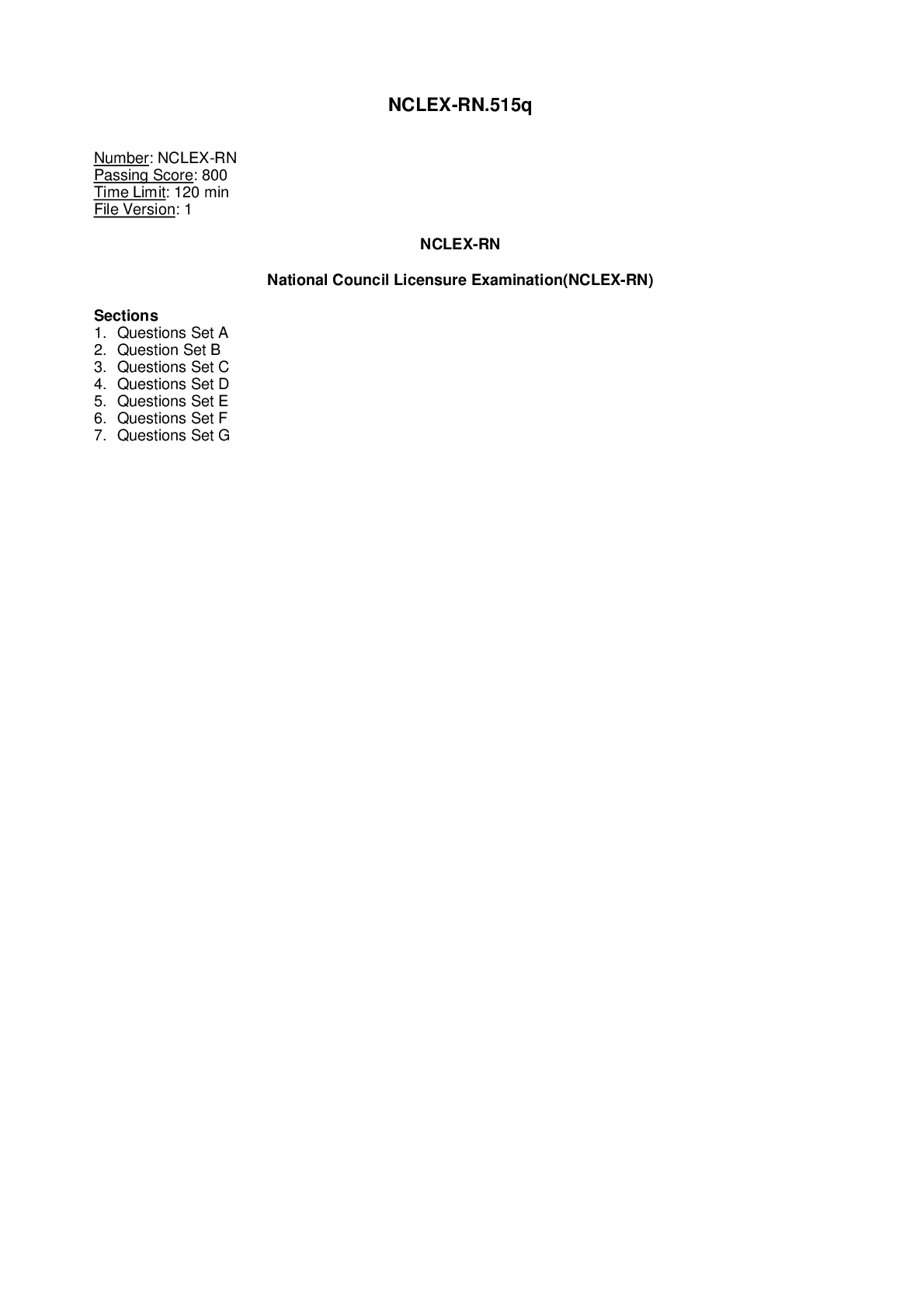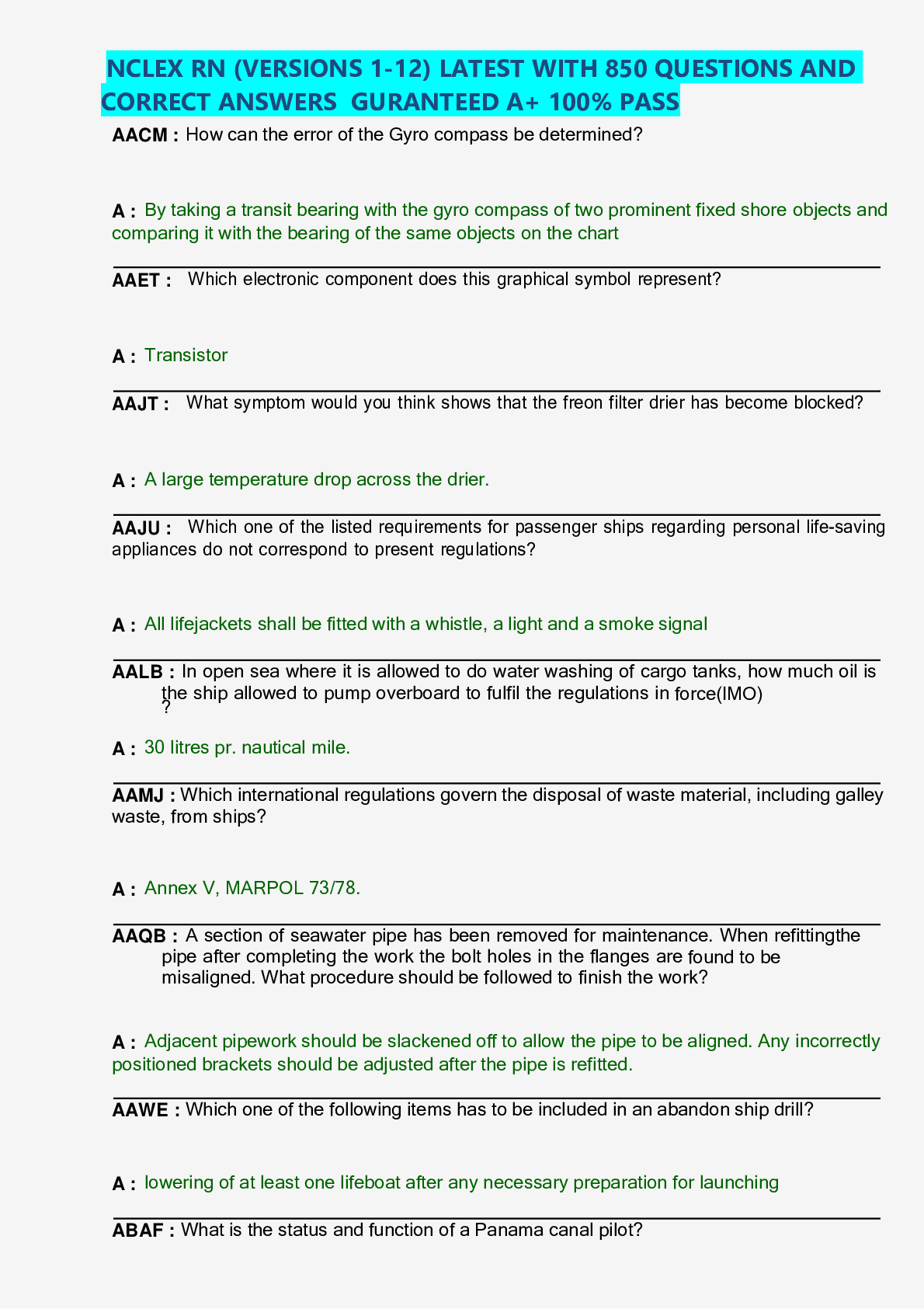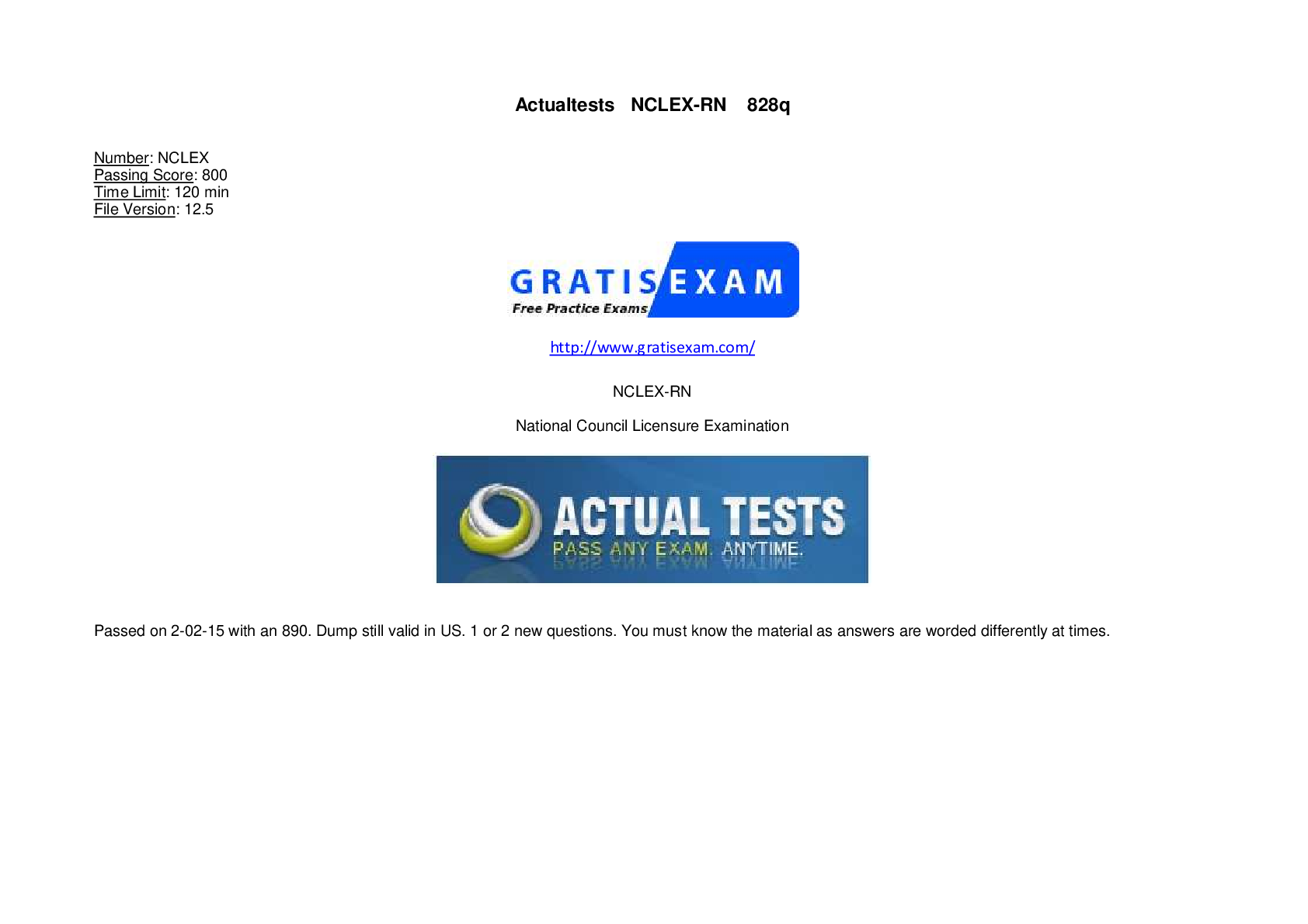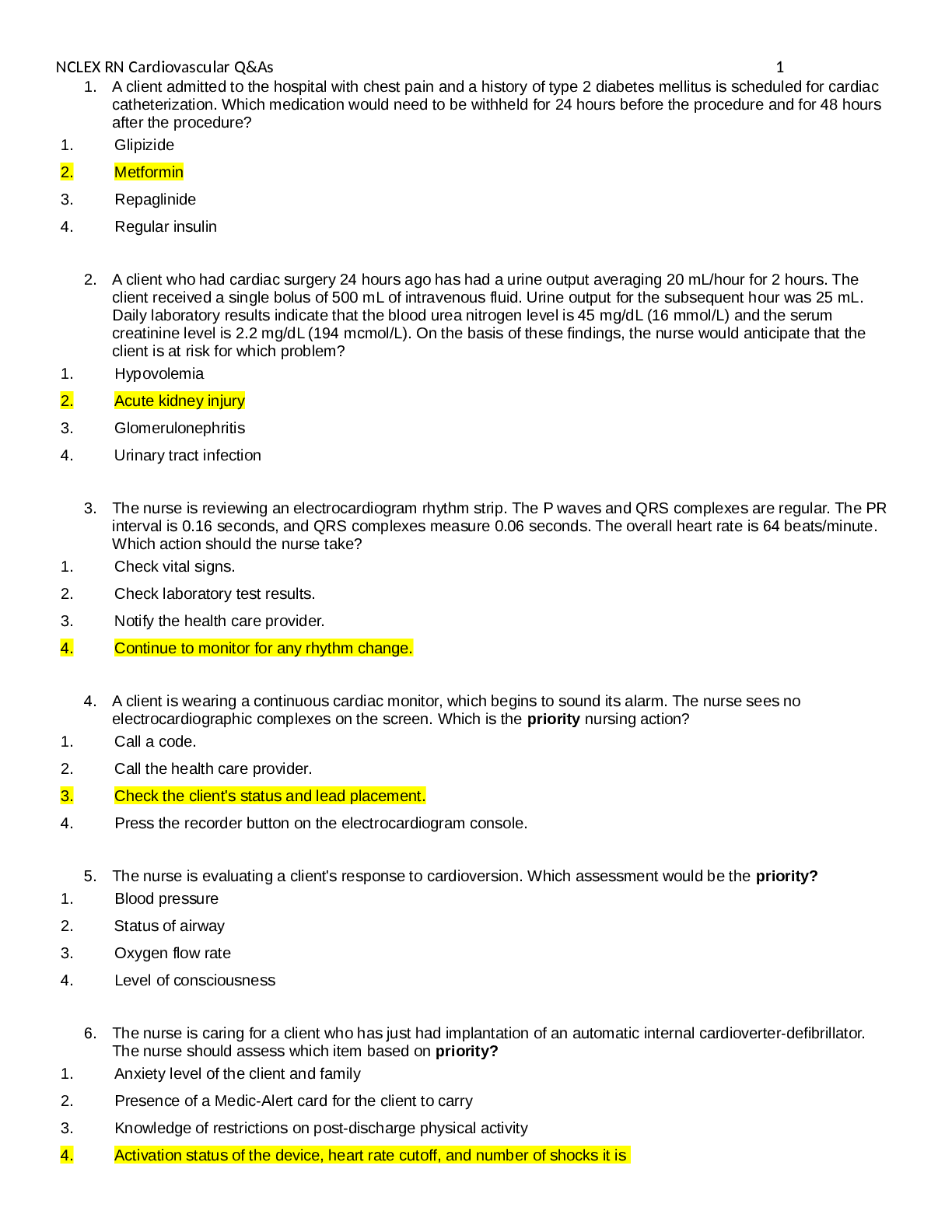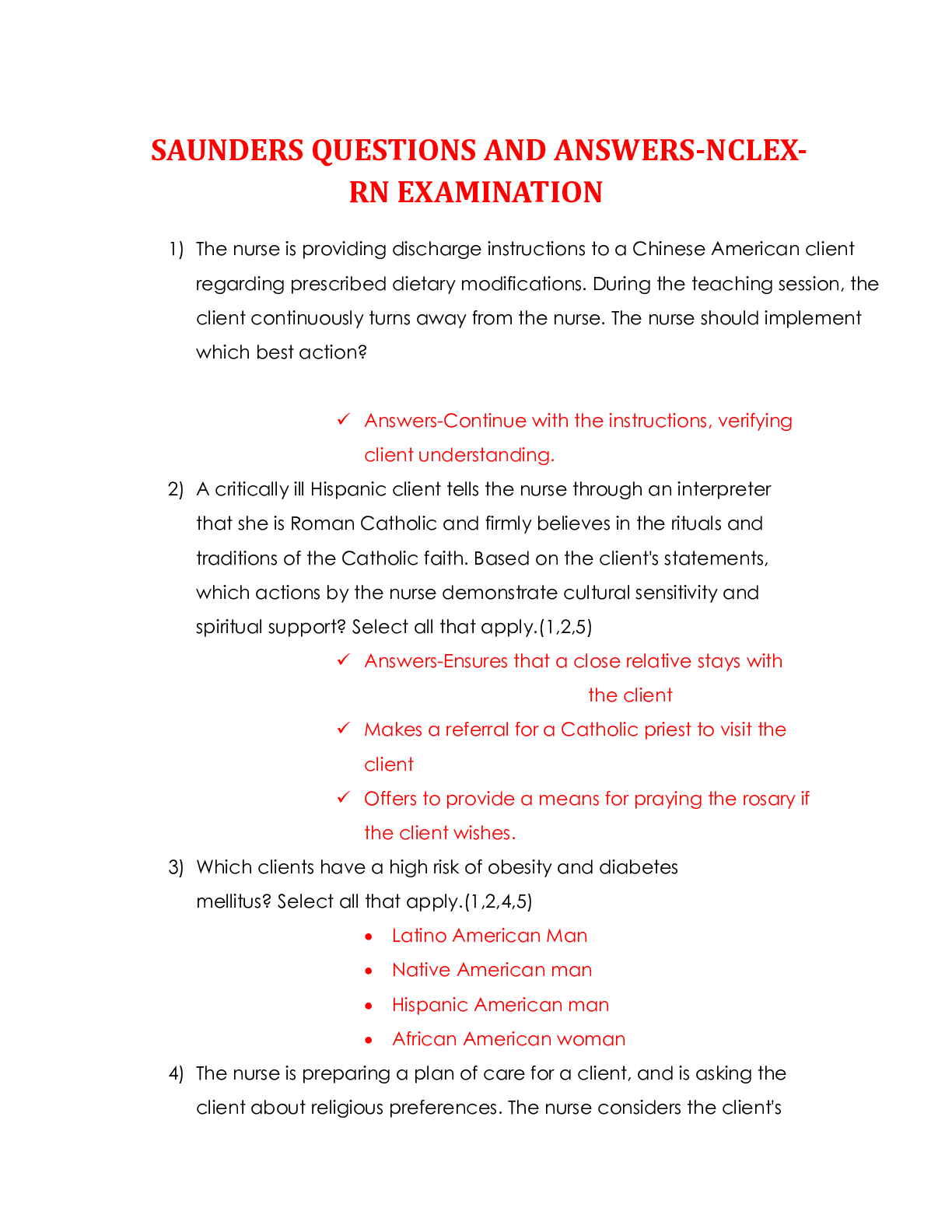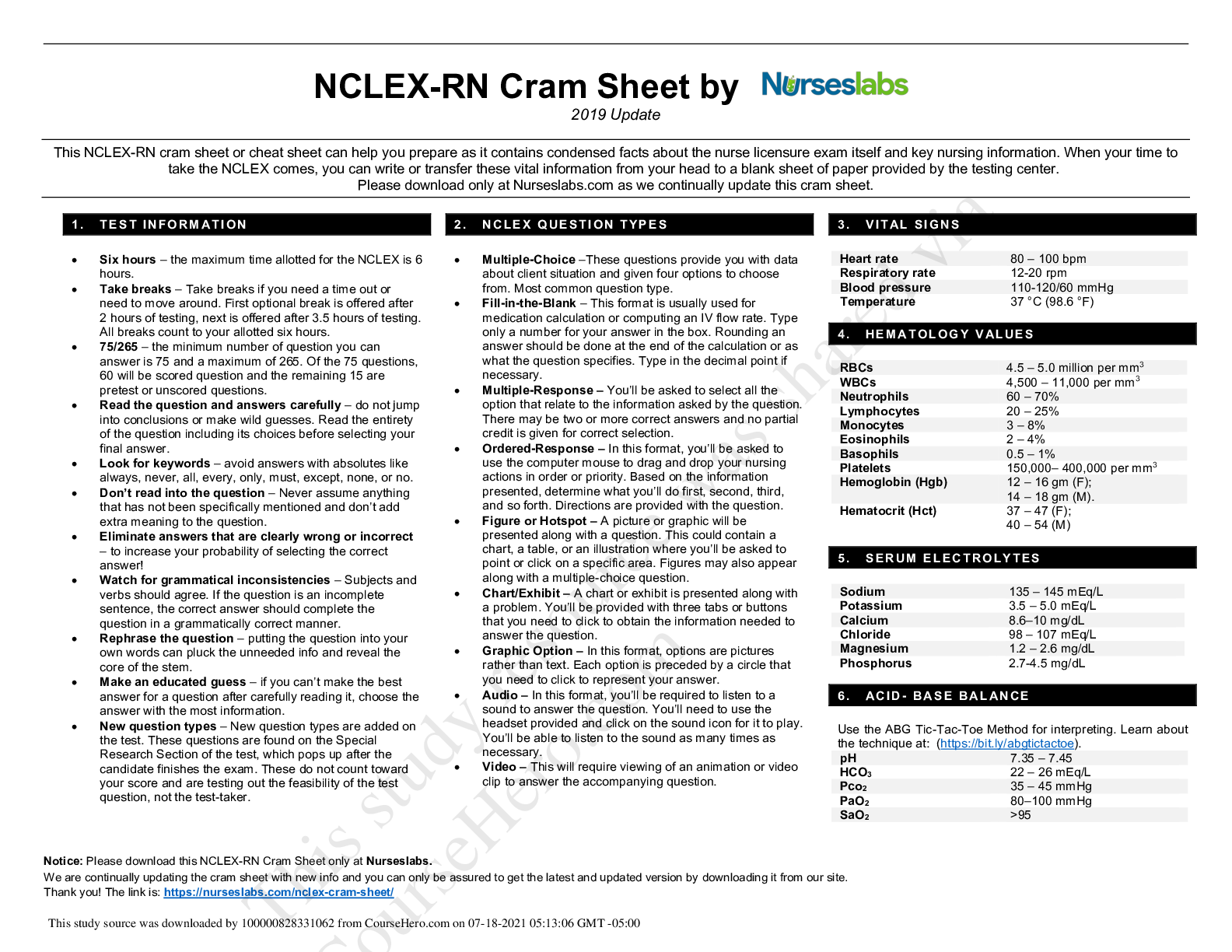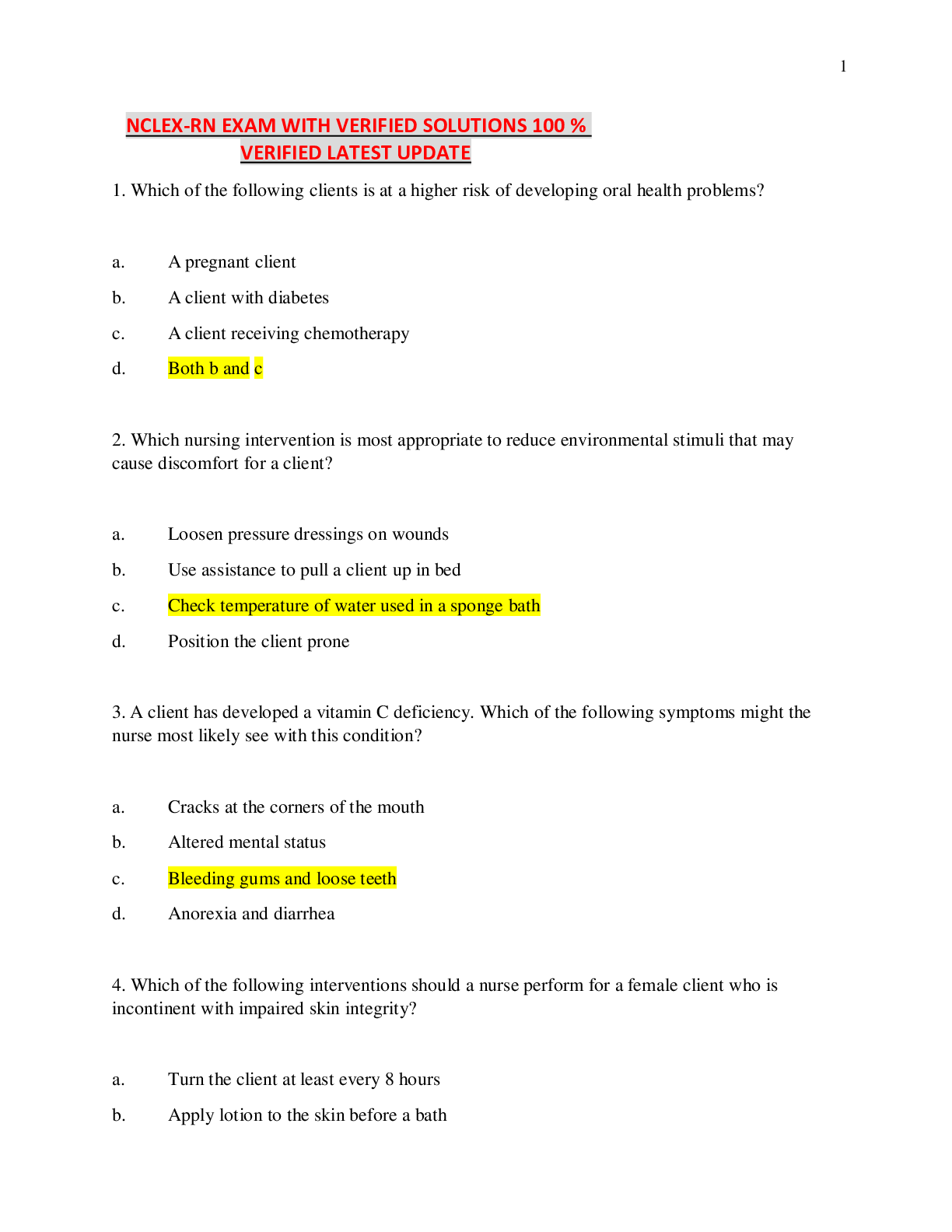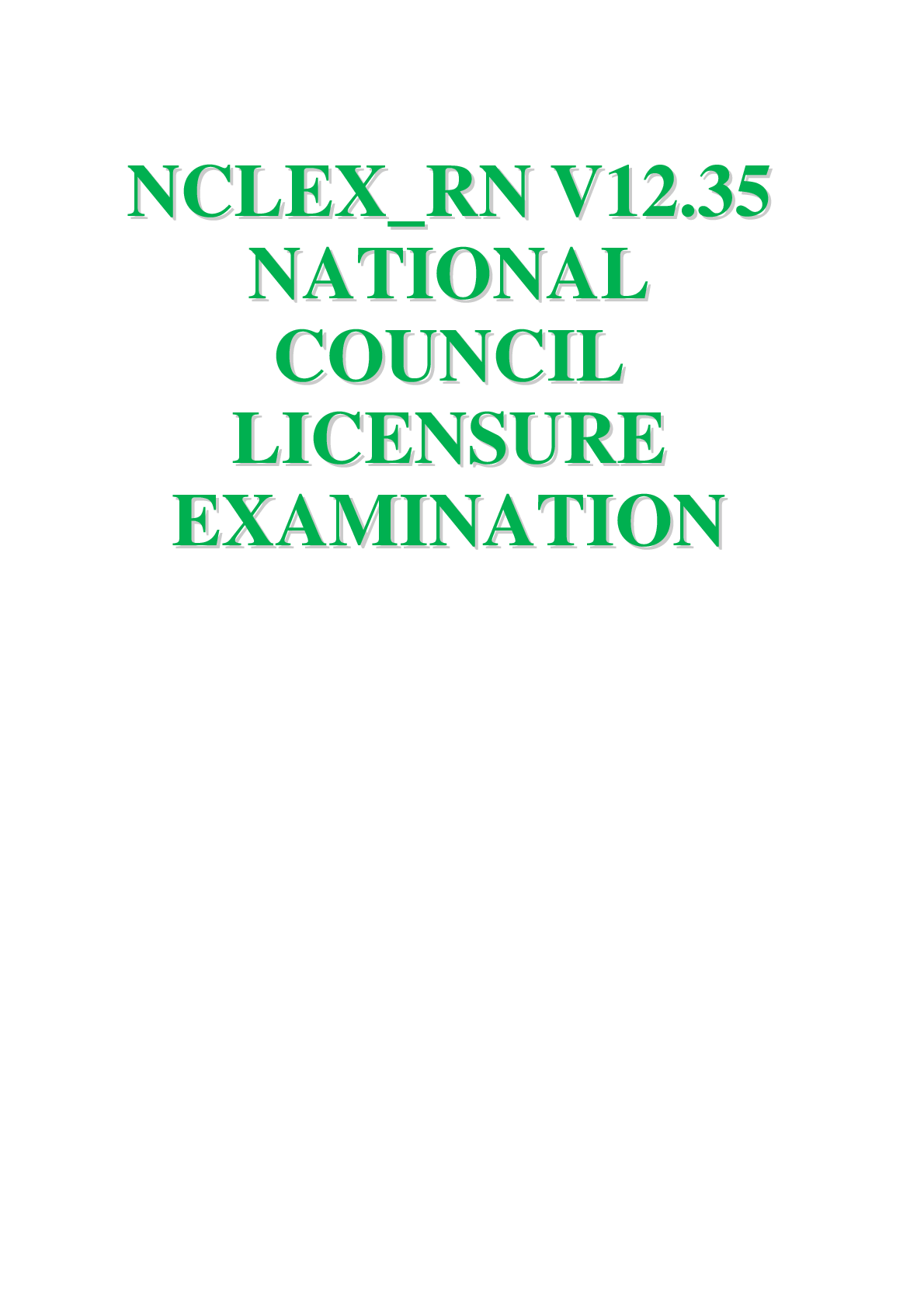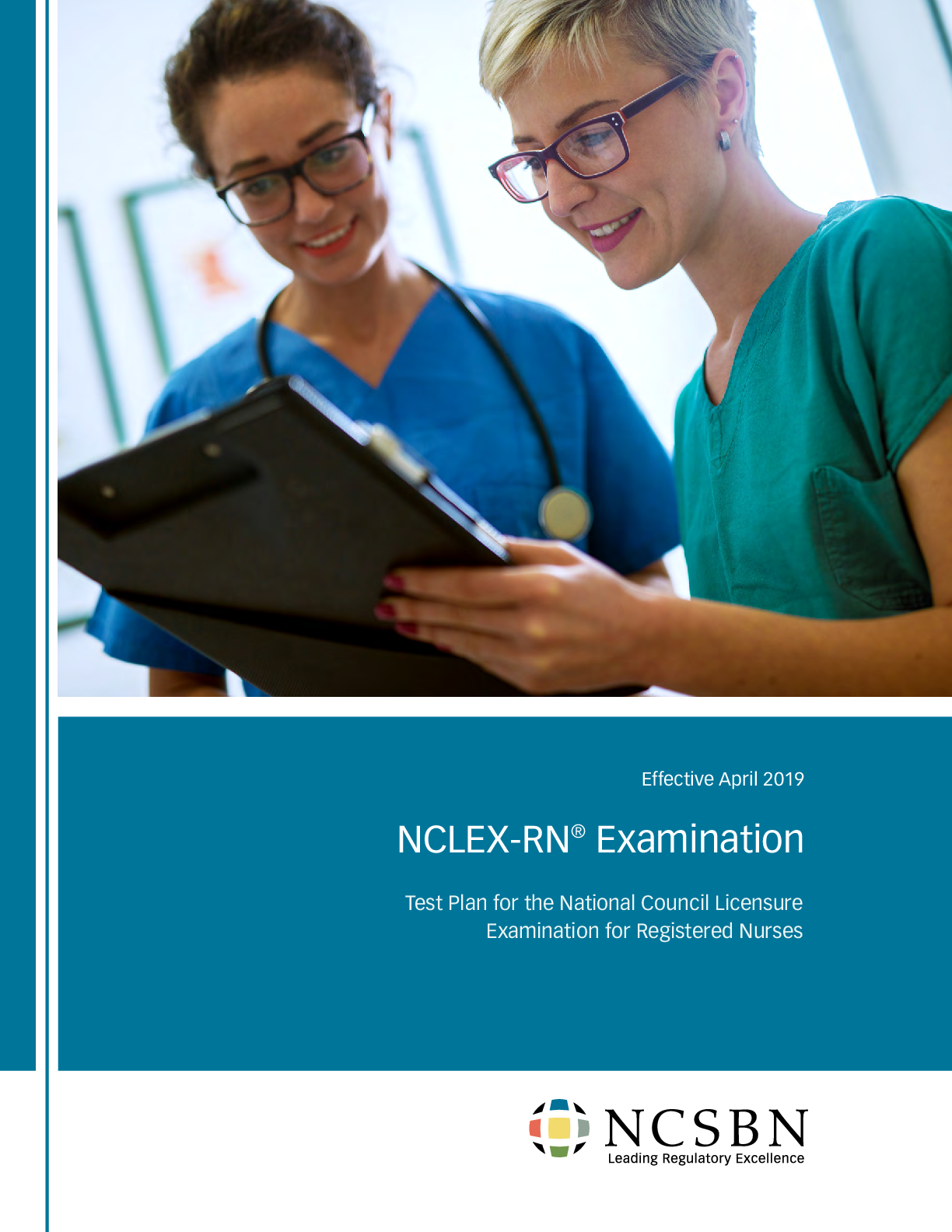*NURSING > NCLEX-RN > Chamberlain College Of Nursing > Board Vitals NCLEX Prep RN 126_Questions and Correct answers (all 1 (All)
Chamberlain College Of Nursing > Board Vitals NCLEX Prep RN 126_Questions and Correct answers (all 100%)
Document Content and Description Below
Board Vitals NCLEX Prep RN 126 1. While administering medications to a group of clients on a medical-surgical unit, a client who is postoperative from an accidental above-the-knee amputation indicates... to the nurse that he is ready to talk about his feelings. The nurse keeps her promise and returns to talk with the client as soon as she finishes administering medications. Which of the following ethical principles is the nurse demonstrating? A. Veracity B. Justice C. Nonmalecence D. Fidelity 2. A nurse has assigned client care activities to an assistive personnel (AP). Which of the following statements by the AP indicates a need for assistance with time management? A. "I will start working with the client in room 1, then work my way to room 10." B. "I will give this client his meal tray first because he is going to physical therapy early." C. "After breakfast, I will pack the belongings of clients who will be discharged this morning." D. "I will start by providing partial baths before breakfast." 3. A nurse is updating the plan of care for a client who has a new diagnosis of hypertension and a prescription for atenolol. Which of the following referrals should the nurse request from the provider as the priority referral? A. Dietitian B. Physical therapist C. Pharmacist D. Social worker 4. A nurse on a pediatric unit is planning care for a group of clients. Which of the following clients should the nurse plan to assess first? A. A school-age child who has diabetes mellitus and requires blood glucose monitoring B. An infant who has pertussis and is receiving oxygen via nasal cannula C. An adolescent who is 1 day postoperative following an appendectomy D. A toddler who is scheduled for an upper gastrointestinal X-ray series 5. A nurse is caring for a client who has terminal lung cancer. The client's provider has recommended hospice services for the client. Which of the following statements by the client should indicate to the nurse that the client understands hospice care? A. "I will have to be admitted to a long-term care facility in order to receive hospice care." B. "I should expect the hospice team to help me manage my difficulty breathing." C. "Hospice care services are available to anyone who is terminally ill, regardless of life expectancy." D. "My oncologist will continue to look for a cure for my cancer while I am receiving hospice care." 6. A nurse in a provider's office is reviewing the laboratory findings for a client who is receiving chemotherapy. The client has a platelet count of 60,000/mm3. Which of the following actions should the nurse take first? A. Provide the client with information about the treatment. B. Discuss these findings with the provider. C. Ask the client to return to the clinic for further laboratory tests. D. Obtain a referral to a specialized provider. 7. A charge nurse is delegating tasks to nursing personnel on a ten-bed dementia care unit. Which of the following assignments is an example of overdelegation? A. Assigning two assistive personnel (AP) to ambulate each client on the unit B. Assigning a newly licensed nurse to perform a wet-to-dry dressing change C. Assigning one AP to feed each client on the unit D. Assigning an experienced RN to perform a central line dressing change 8. A nurse on a medical-surgical unit is delegating care for a group of clients. Which of the following specimens should the nurse delegate an unlicensed assistive personnel (UAP) to collect? A. Wound drainage for culture B. Urine from an indwelling catheter C. Blood for an ABG test D. Random stool specimen 9. A nurse accuses a newly licensed nurse of providing inadequate care for a client who underwent hip arthroplasty. Which of the following responses by the newly licensed nurse demonstrates assertiveness? A. "I feel as though I met the standard of care. Would you tell me more about your concerns?" B. "You shouldn't make accusations. Your nursing care doesn't always set a good example." C. "I am sorry you are displeased. I always do my best to give good care to my clients." D. "Yes, you might be right. I haven't had the best role models since I started this position. 10. A nurse is caring for a client who is participating in a research study for an experimental chemotherapy medication. After three treatments, the experimental medication is discontinued due to evidence of rapidly advancing kidney failure. The nurse should recognize that discontinuing this medication demonstrates which of the following ethical principles? A. Justice B. Autonomy C. Fidelity D. Nonmalecence 11. A nurse on a quality assurance team is reviewing unit incident reports that were led within the last six months. Which of the following incidents meets the criteria for a sentinel event? A. A client who was postoperative from surgery reported a valuable piece of jewelry was stolen from his room. B. A client who was experiencing acute alcohol withdrawal hits a nurse, causing the nurse to fall to the floor and break their wrist. C. A client who was having an anaphylactic reaction was administered epinephrine 0.75 mg intramuscularly. The client experienced a cardiac event and died. D. An AP left a client on fall precautions unattended in the restroom, where the client fell and sustained a scrape to the knee. 12. A nurse manager is reviewing the admission history of four adult clients. The nurse is required to report which of the following situations to an outside agency? A. An older adult client who is dependent on caregivers and was admitted for the treatment of burns on the buttocks B. A young adult client who was admitted for asthma and has track marks that might indicate IV substance use C. A young adult client who was admitted for acute glomerulonephritis following a viral infection D. An emancipated minor who has acute appendicitis and wants to leave the facility without treatment 13. A nurse is planning an in-service for nursing staff about managing care for clients who develop disequilibrium syndrome. Which of the following interventions should the nurse include in the teaching? A. Administer an opioid medication. B. Monitor for the development of chest pain. C. Assess level of consciousness. D. Start an intravenous infusion of dextrose 50% 14. A nurse is preparing to delegate tasks to an LPN and an assistive personnel (AP). Which of the following tasks should the nurse assign to the LPN? A. Transporting a client who experienced a stroke 72 hr ago to the radiology department B. Providing a back rub to a client who has right-sided paralysis C. Removing and cleaning the cannula of a client who has a stable, exisiting tracheostomy D. Emptying the drainage from the ostomy bag of a client who has a new colostomy 15. A nurse is planning an education program about heart health for adults in the community. Which of the following principles should the nurse use when planning the program? A. The program should be teacher-directed. B. The content of the program should be problem-centered. C. The goals of the program should be set by the teacher. D. The program should be conducted in a formal atmosphere. 16. A nurse is teaching a client about choosing a health care surrogate. Which of the following statements by the client indicates an understanding of the teaching? A. "I can change who I designate as my health care surrogate as long as I have my provider's approval." B. "If I become incapacitated, end-of-life choices will be made by my health care surrogate." C. "I have to choose a family member as my health care surrogate." D. "I can verbally indicate to my nurse who I want to assign as my health care surrogate." 17. A nurse manager is planning strategies to overcome resistance among unit nurses for a proactive policy change. Which of the following interventions should the nurse include? A. Emphasize that future revisions to the policy change are not an option. B. Openly discuss the reason for the change. C. Avoid redirecting the resistance of the nursing staff until opposition is resolved. D. Emphasize the reason for the change rather than the benefits of the change 18. A nurse in a preoperative unit is caring for a client who is scheduled for surgery. The nurse is a witness on the client's consent form. The nurse provides a signature on the consent form for which of the following purposes? A. Ensuring the client is of age to sign the form B. Confirming the client appears competent to provide consent C. Asserting the nurse has explained the risks and benefits of the procedure D. Recording that the client's partner agrees the procedure is necessary 19. A nurse is completing a medication reconciliation with a newly licensed nurse on a client admitted to the unit from the emergency department. Which of the following statements by the newly licensed nurse indicates an understanding of the process? A. "The American Hospital Association requires accredited facilities to have protocols in place requiring medication reconciliation." B. "The purpose of medication reconciliation is to compare the medications a client is taking with newly prescribed medication." C. "When I perform medication reconciliation, I am demonstrating the ethical principal of veracity." D. "I should perform a medication reconciliation once each shift." 20. A client who has liver cancer informs the nurse that the provider has recommended that she consider receiving a liver transplant. The client tells the nurse she does not want to pursue this option because she "has already been through enough suffering." Which of the following responses should the nurse make? A. "It is your right to make decisions regarding your care." B. "Your doctor made this recommendation because she feels you are a good candidate for a transplant; perhaps you should reconsider your decision." C. "Your family is supportive; maybe you should allow them to make the decision." D. "Liver transplants are a common procedure at this hospital, so you shouldn't have to worry about having complications." 21. A nurse is presenting an in-service about delegation to a group of newly licensed nurses. Which of the following statements by a newly licensed nurse indicates an understanding of the teaching? A. "Delegation ensures the client receives appropriate resources." B. "Delegation permits a designated individual to meet a goal on your behalf." C. "Delegation promotes client discharge teaching by unlicensed personnel." D. "Delegation shifts accountability to the individual performing the task." 22. A nurse is providing dietary teaching to a client who has dysphagia following a stroke. Which of the following instructions should the nurse include in the teaching? A. "Rest for 15 minutes prior to meals." B. "Place food in the weaker side of your mouth to chew." C. "Sit up in a chair for 20 minutes after eating." D. "Flex your head with your chin tucked down to assist with swallowing." 23. A nurse in an urgent care clinic is triaging clients. Which of the following clients should the nurse identify as the priority for the provider to examine? A. An adolescent client who is confrontational has decreased reasoning and has slurred speech B. A toddler who has a laceration on the forehead and is screaming C. A middle adult client who is diaphoretic and reports epigastric pain D. A young adult who has a painful sunburn over the face and arms 24. A nurse is completing an incident report for a client who has fallen. Which of the following actions should the nurse take? A. Make a copy of the incident report for the provider. B. Submit the incident report to the risk manager. C. Place the incident report in the client's medical record. D. Document in the medical record that an incident report has been led 25. A nurse is caring for a client who had a stroke 3 days ago and has developed dysphagia. The nurse should identify that a referral to which of the following members of the interdisciplinary team is the priority? A. Pharmacist B. Occupational therapist C. Dietitian D. Speech therapist 26. A charge nurse hears a provider yelling at a staff nurse about the lack of supplies available to perform a procedure. Which of the following statements by the charge nurse is appropriate? A. "You should think about how you make others feel when you lose your temper." B. "I will help you with this procedure instead of the staff nurse." C. "It must be very frustrating when you don't have what you need to perform the procedure." D. "No one knew you were planning to perform a procedure. We cannot be blamed for not having the supplies needed." 27. A charge nurse assigns an obstetrical (OB) nurse to oat to the acute medical-surgical (AMS) unit due to a staffing shortage. The nurse does not feel comfortable with the assignment. Which of the following actions should the nurse take? A. Refuse the assignment and remain on the OB unit. B. Ask the charge nurse to appoint a resource nurse on the AMS unit. C. Report the charge nurse for unsafe client care practices. D. Float to the AMS unit and perform certified nursing assistant (CNA) duties. 28. A nurse is preparing to administer a bisacodyl enema to a client who has constipation. The client states, “The doctor didn't tell me I was supposed to receive an enema." Which of the following actions should the nurse take first? A. Check the client's medication administration record for the provider's prescription. B. Explain the procedure to the client. C. Assure the client that enemas are often prescribed for constipation. D. Assist the client to the left lateral position. 29. A nurse is providing teaching about home tracheostomy care to the partner of a client who is to be discharged. When considering cost-effective care, which of the following instructions should the nurse give to the partner? A. Wear clean gloves when suctioning the client's tracheostomy. B. Rinse and dry suction catheters and reuse for up to 24 hr. C. Empty and rinse the suction container in a sink every 24 hr. D. Discard oral suction tubes (Yankauer) after each use. 30. A nurse is caring for a client who has a terminal illness and is using a ventilator. The client is alert and oriented and tells the nurse he wants to discontinue the use of the ventilator. The nurse should identify that continued treatment against the client's wishes is a violation of which of the following ethical principles? A. Veracity B. Autonomy C. Utility D. Justice 31. A nurse on an oncology unit accidently administered doxorubicin to the wrong client, resulting in harm to the client. This action is an example of which of the following torts? A. Battery B. Invasion of privacy C. Malpractice D. Assault 32. A nurse is providing change-of-shift report about a group of clients to the oncoming nurse. Which of the following information should the nurse include in the report? A. "Mr. Rodriguez in room 200 needs another IV bag at 0700." B. "Mrs. Smith in room 201 had a visitor yesterday evening." C. "Mr. Jones in room 202 had routine vitals obtained this morning." D. "Mrs. Hassler in room 203 is grumpy after waking up." 33. A nurse is planning discharge for a client who has cirrhosis and experienced ascites and esophageal varices during hospitalization. The nurse should collaborate with which of the following members of the interdisciplinary team to perform specialized care for this client A. A physical therapist to teach the client how to live with paralysis of the lower extremities B. A dietitian to teach about a low-sodium diet C. A social worker to attend to the spiritual needs of the client D. A pharmacist to teach about home warfarin therapy 34. A charge nurse assigns a client's dressing change to a licensed practical nurse (LPN). Several hours later, the client reports that the dressing has not been changed. Which of the following actions should the charge nurse take? A. Inform the client that the task had been delegated hours ago. B. Reassign the task to another nurse. C. Ask the LPN to discuss why the dressing change has not been completed. D. Report the issue to the unit manager. 35. A nurse is obtaining informed consent for treatment from a 16-year-old adolescent who has a sexually transmitted infection. The nurse should identify that which of the following individuals can provide consent for the adolescent? A. Client B. Physician C. Client's older sibling D. A visibly intoxicated parent 36. A staff nurse asks an assistive personnel (AP) to ambulate a client and the AP refuses. Which of the following actions should the nurse take? A. Ambulate the client. B. Dismiss the AP. C. Complete an incident report. D. Ask the AP about her concerns with the assignment. 37. A nurse is planning care for a group of clients and assigning tasks to a licensed practical nurse (LPN) and an assistive personnel (AP). Which of the following tasks should the nurse assign to the LPN? A. Complete an admission assessment for a client who has COPD. B. Measure the drainage of a client who has a closed-suction drain. C. Reinforce teaching to a client about taking enoxaparin at home following a hip arthroplasty. D. Develop a plan of care for a client who has cholecystitis 38. A nurse is participating in a disaster simulation in which a toxic substance has been released into a crowded stadium. Multiple clients are transported to the facility. Which of the following actions should the nurse take first? A. Prevent cross-contamination of clients. B. Complete a thorough client assessment. C. Treat clients arriving at the facility who have yellow triage tags. D. Maintain a client tracking system. 39. A charge nurse is making team assignments for an Registered Nurse (RN) and a Licensed Practical Nurse (LPN). Which of the following clients should the charge nurse assign to the RN? A. A client who has continuous bladder irrigation B. A client who is in protective isolation C. A client who is actively dying and requires IV pain medication D. A client who is 3 days postoperative and requires a dressing change 40. A nurse is serving on a committee that is exploring the use of the auditing process to improve client care at a facility. Which of the following aspects of client care should the nurse identify as measured by a process audit? A. Availability of supplies B. Nursing staff ratios C. How nursing care was provided D. Results of a specific nursing intervention 41. A critically ill client with terminal cancer is admitted with pneumonia. The client tells the nurse that he has a living will and does not want to be resuscitated. Which of the following is the most appropriate nursing action? A. Inform the healthcare provider B. Request a copy of the client’s Living Will to place in the medical record C. Ask the client if his spouse is aware of his request D. Ask the client if he has a Durable Power of Attorney for Health Care 42. A nurse is conducting an education session about maintaining condentiality of the electronic medical record (EMR) with a group of newly hired nurses. Which of the following statements by a newly hired nurse demonstrates an understanding of the information? A. "I should log off the EMR on the client's in-room computer if I need to leave the room to collect supplies." B. "If I use worksheets for planning care for my clients, I should discard them in the wastebasket at the end of the shift." C. "I can permit any staff member in our facility to see information on my client's EMR." D. "I can share my facility computer password with the nurses on my client's care team 43. A nurse is obtaining informed consent from a client who is scheduled for a surgical procedure. Which of the following actions should the nurse take? (Select all that apply.) A. Establish that the client is able to pay for the surgical procedure. B. Explain the risks and benefits of the surgical procedure to the client. C. Validate the signature is authentic. D. Verify the client's understanding of the surgical procedure. E. Confirm that the consent is voluntary. 44. A nurse is caring for a client who is 1 day postoperative following an abdominal hysterectomy. The assistive personnel (AP) reports to the nurse that the client's dressing is saturated with blood. Which of the following tasks should the nurse delegate to the AP? A. Change the abdominal dressing. B. Obtain dressing supplies. C. Palpate for possible bladder distention. D. Notify the provider. 45. A nurse is planning to delegate tasks to a licensed practical nurse (LPN). Which of the following tasks should the nurse assign to the LPN? A. Develop the plan of care for a client who has an amputation. B. Obtain informed consent for a client scheduled for ostomy creation. C. Access an implanted vascular access device. D. Change the negative pressure wound therapy dressing on a client's chronic wound. 46. A nurse is preparing to delegate the task of obtaining clients' vital signs to an assistive personnel (AP). Which of the following actions should the nurse plan to take? A. Verify the AP has passed the facility's annual competency training prior to delegating the task. B. Communicate the time frame for when the AP should report the results. C. Observe the AP as she obtains the vital signs of each client. D. Ask the AP to take the vital signs of a client who is immediately postoperative. 47. A nurse is caring for a client who is scheduled for surgery. The nurse should identify that which of the following actions is the responsibility of the nurse? A. Describe the steps of the procedure B. Explain the risks involved with the procedure C. Discuss alternate treatment options D. Determine the client's level of understanding about the procedure 48. A charge nurse is delegating several client care tasks. Which of the following tasks should the nurse delegate to another Registered Nurse (RN) A. Collecting a urine specimen from a client who has diabetes mellitus to test for ketones B. Obtaining a wound drainage specimen from a client who has a wound that is red and painful C. Obtaining a stool specimen for an occult blood test from a client who requires screening for colon cancer D. Obtaining an expectorated sputum sample from a client who is being evaluated for tuberculosis 49. An RN is preparing assignments for a licensed practical nurse (LPN) and an assistive personnel (AP). Which of the following tasks should the nurse assign to the LPN? A. Providing postmortem care for a client B. Measuring a client's I&O C. Obtaining a client's weight D. Inserting an indwelling urinary catheter for a client 50. A nurse is caring for a client who becomes unresponsive and develops asystole. The family has previously requested that the client not be resuscitated. However, there is not a do-notresuscitate (DNR) order from the provider in the client's chart. Which of the following actions should the nurse take? A. Call the emergency response team. B. Notify the risk manager of the situation. C. Call the provider for a stat DNR order. D. Respect the family's wishes and withhold any treatment. 51. A nurse is assessing a client who experienced a traumatic brain injury. Which of the following findings is the nurse's priority? A. Glasgow coma scale score of 10 B. BP dropped from 150/74 to 143/80 mm Hg in 1 hr C. Pupils are round and 6 mm in diameter D. 3 cm (1 in) clear drainage from client's ear on gauze dressing 52. A charge nurse is teaching a newly licensed nurse about the quality improvement process in the acute care setting. The charge nurse should include which of the following in the teaching A. The main focus of quality improvement is to improve the delivery of nursing care at the bedside. B. Reports of client satisfaction typically focuses on how quickly their health condition improved. C. Employees at all levels of the organization should be involved in quality improvement D. One staff member on each nursing unit should be designated to monitor for quality care issues 53. A nurse checks with assistive personnel on the unit throughout the shift to determine if assigned tasks are being completed in a timely manner. Which of the following rights of delegation is the nurse demonstrating? A. Right circumstances B. Right communication C. Right task D. Right supervision 54. A charge nurse on a medical-surgical unit has just been notified that the disaster protocol is being implemented following a natural disaster. Which of the following actions should the nurse take? A. Make a list of clients who can be discharged. B. Reinforce discharge teaching to clients. C. Instruct the assistive personnel (AP) to focus on clients' ADLs. D. Stock additional unit supplies. 55.A nurse is delegating tasks to an unlicensed assistive personnel (UAP). Which of the following tasks should the nurse instruct the UAP to complete first? A. Obtain a capillary blood glucose for a client who is prescribed premeal insulin B. Apply a condom catheter to a client who has urge urinary incontinence. C. Feed a client who has bilateral casts due to upper arm fractures. D. Ambulate a client who requires the use of a walker. 56. A nurse in an emergency department is caring for a client who has a compression fracture of a spinal vertebra that requires surgery. The client has received morphine for pain, and the nurse is unable to contact the client's family. Which of the following actions should the nurse expect the neurosurgeon to take? A. Invoking implied consent B. Delaying the surgery until a family member is reached C. Asking the client to sign the surgical consent form D. Prescribing naloxone to reverse the effects of the morphine 57. A nurse manager is planning to teach the nurses on the unit about a new infusion pump. Which of the following teaching strategies is the most effective way to ensure that the staff can use the device correctly? A. Create a step-by-step instructional handout about using the device for the staff to review. B. Demonstrate using the device and observe the staff returning the demonstration. C. Remind the staff to review the procedure manual prior to using the new pump. D. Show a video about the new infusion pump during an in-service. 58. A nurse is teaching a group of assistive personnel (AP) about performing hand hygiene. Which of the following statements should the nurse include in the teaching? A. "You should avoid wearing artificial nails." B. "You may wear your rings when washing your arms and hand." C. "You can grow your fingernails any length." D. "You can use your own personal hand lotion after washing your hands " 59. A nurse is caring for a client who is scheduled for surgery. Which of the following actions should the nurse take? A. Identify the client with one identifier before marking the surgical site. B. Explain the risks and benefits of the procedure. C. Review preoperative laboratory test results. D. Contact an attorney to review the advance directives. 60. A nurse is caring for a client who is actively dying. Which of the following actions by the nurse demonstrates the ethical principle of nonmalecence? A. Discussing advance directives with the client and the client's family B. Providing comfort care measures to the client C. Withholding a dose of pain medication when the client has respiratory depression D. Giving the client privacy during perineal care 61. A nurse is caring for a client who has pneumonia. Which of the following tools should the nurse use to assist with providing cost-effective care? A. Chart audit B. Practice guideline C. Acuity rating D. Critical pathway 62. A nurse is caring for a client who has Crohn's disease and is scheduled for a colon resection. The client states, “I have changed my mind and I don't want to have the surgery." Which of the following responses should the nurse make? A. "It is normal to be nervous before surgery." B. "I will notify the provider about your decision." C. "You will feel better after the surgery." D. "If you don't have the surgery, you could die." 63. A nurse is caring for a client who has right sided paralysis following a stroke. Which of the following information should the nurse provide the occupational therapist who will be involved in the care of the client? A. The client will need a ramp built at his home. B. The client is experiencing difficulty swallowing liquids. C. The client is right-hand dominant. D. The client wishes to complete an advance directive. 64. A nurse on a medical surgical unit is deciding which clients can be discharged to make beds available for injured clients following a mass casualty event. Which of the following clients should the nurse recommend for discharge? A. A young adult client who has Crohn's disease and is scheduled for an ileostomy in 24 hr B. An adolescent client who was admitted 24 hr ago due to a spontaneous pneumothorax C. A middle adult who is 36 hr postoperative following an open laminectomy D. An older adult client who was admitted for acute pancreatitis 65. A nurse is preparing to administer a prescribed dose of furosemide at 0700 to a client who has heart failure. The client states, “I don't want to take this medication because it makes me feel sick and dizzy." Which of the following nursing actions demonstrates client advocacy? A. Teaching the client about the importance of diuretics to treat heart failure B. Reinforcing that the client should request help when ambulating after taking the medication C. Asking the client if she would like the nurse to contact the provider to discuss the concerns D. Reassuring the client that furosemide administration could be delayed until after breakfast 66. A nurse is planning care for a client who has anorexia nervosa and has been admitted for cardiac arrhythmias. Which of the following client goals should the nurse identify as the priority? A. Attain a weight that is greater than the 75th percent for ideal body weight. B. Acknowledge misperceptions about body image. C. Verbalize having a sense of control over behaviors. D. Identify changes within the client's family unit that promote the client's autonomy. 67. A nurse is teaching a newly licensed nurse about delegating tasks to assistive personnel (AP). Which of the following statements by the newly licensed nurse indicates an understanding of the teaching? A. "The nurse relinquishes accountability for client outcomes when care is delegated to an AP." B. "The AP can provide client education about how to perform basic self-care to the client." C. "The nurse should consider the AP's level of experience when making delegation decisions." D. "The nurse should delegate all tasks that don't require specialized skill or knowledge to an AP." 68. A nurse manager is teaching a group of charge nurses about the recruiting and retention process for health care workers. Which of the following statements should the nurse manager include? A. "Recruiting new employees occurs as the need arises." B. "Retention occurs due to monetary compensation." C. "Retention is improved when the middle-level manager creates a positive social climate." D. "Recruiting by word of mouth does not improve retention." 69. A nurse is assessing a client who is postoperative following a radical mastectomy. The client reports a pain level of 8 on a scale from 0 to 10. The nurse states that she will return soon with prescribed pain medication and follows through with this act. Which of the following ethical principles is the nurse demonstrating? A. Justice B. Fidelity C. Autonomy D. Nonmalecence 70. A nurse and an assistive personnel (AP) are providing care to a group of clients. The nurse should delegate assisting which of the following clients with their meal to the AP? A. A client who has a lumbosacral spinal tumor B. A client who has Guillain-Barré syndrome C. A client who has amyotrophic lateral sclerosis (ALS) D. A client who receives enteral feedings through a nasogastric tube 71. A nurse is planning to delegate tasks to an assistive personnel (AP). Which of the following factors should the nurse consider when using the five rights of delegation? A. The AP's ability to prioritize B. The AP's knowledge and skill to perform the task C. The AP's work experience at the facility D. The AP's ability to complete the task without supervision 72. A nurse has just received report on a group of clients for the upcoming shift. Which of the following actions by the nurse demonstrates effective time management skills? A. Identify tasks that are time-specific. B. Gather supplies as needed during client care. C. Skip breaks to review clients' laboratory values. D. Document client care at the end of the shift. 73. A nurse manager is working to maintain fiscal and ethical accountability for the staffing. Which of the following actions should the nurse take? A. Increase staffing when acuity levels are low. B. Ask the staff to regularly work extra shifts and overtime. C. Create a sense of trust to resolve staffing issues. D. Focus on the number of personnel for client care. 74. A nurse is observing an assistive personnel (AP) who is bathing a client in bed. The nurse should identify that which of the following actions by the AP indicates correct technique? A. Pulling the curtain around the client's bed B. Washing the client's perineal area first C. Using a washcloth to wipe the client's eyes from the outer canthus to the inner canthus D. Filling the bath basin with tap water that is 39° C (102.2° F) 75. A nurse is caring for a client who is scheduled for a total hip arthroplasty. Which of the following tasks is the nurse's responsibility? A. Verify that the client understands the procedure they are having done. B. Explain the procedure to the client. C. Inform the client of the risks of the procedure. D. Provide information about alternate treatments. 76. A nurse manager is investigating reports from nurses who report a staff nurse on the previous shift frequently leaves tasks uncompleted. The nurse manager notes that the staff nurse delegates an unfair share of tasks to the assistive personnel (AP). Which of the following statements should the nurse manager make to the staff nurse? A. "I need to talk to you about unit expectations regarding delegating and completing tasks." B. "Several staff members have commented that you don't do your fair share of the work." C. "If you don't do your share of the work, I will have to file a written admonishment." D. "You have been very inconsiderate of others by not completing your share of the work. 77. A charge nurse is making assignments for the oncoming shift. Which of the following considerations should the charge nurse consider when making the assignments? A. The National Patient Safety Goals B. Personal comfort level in making the assignments C. Social relationships between nurses working the oncoming shift D. The physiologic status of the clients on the unit 78.A nurse on a medicalsurgical unit is completing an online critical care and emergency nursing course prior to transferring to an intensive care unit (ICU). The nurse should identify that taking the course is demonstrating which of the following ethical principles? A. Veracity B. Autonomy C. Justice D. Nonmalecence 79. A nurse manager is planning an in-service about conflict management for the nurses on the unit. Which of the following situations should the nurse manager include as an example of interpersonal conflict? A. Nurses on the unit disagree about the time of day that daily client weights should be obtained. B. A nurse is uncertain about joining a professional nursing organization. C. Nurses on the unit voice their concern at the budget cuts implemented by the administration. D. An experienced nurse is uncivil to a newly licensed nurse. 80. A nurse is delegating client care to a team of staff members. Which of the following tasks should the nurse assign to an assistive personnel (AP)? A. Set up a sterile field for a surgical dressing change. B. Obtain a scheduled blood glucose reading from a client. C. Instruct a client about how to use an incentive spirometer following surgery. D. Administer a rectal suppository to a client who has constipation. 81. A nurse manager is planning to announce a major change on the unit. Which of the following communication techniques should the nurse manager use to enhance the importance of the announcement? A. Present the announcement to unit staff in a conference room. B. Stand with arms crossed when giving the announcement. C. Stare at the people the announcement will affect the most. D. Pause frequently when making the announcement. [Show More]
Last updated: 1 year ago
Preview 1 out of 28 pages

Reviews( 0 )
Document information
Connected school, study & course
About the document
Uploaded On
May 29, 2021
Number of pages
28
Written in
Additional information
This document has been written for:
Uploaded
May 29, 2021
Downloads
0
Views
52

